P55 Extreme Overclockers: Check your sockets!
by Rajinder Gill on October 15, 2009 12:01 AM EST- Posted in
- Motherboards
We start with a picture.
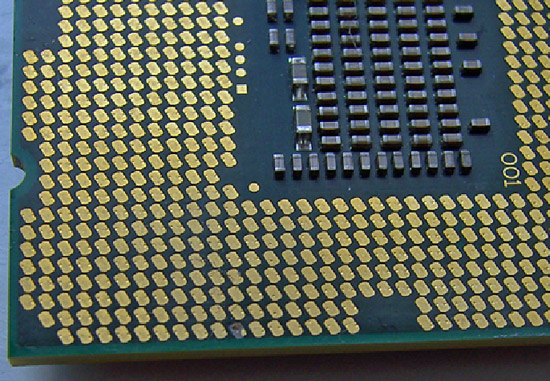
The picture above is after our Core i7 870 (LGA-1156) processor was overclocked up to 5.19GHz using our cascade with a -102° Celsius evaporator head temperature under full-load. Processor VCC power draw at these frequencies is around 160W (this is possible only due to subzero cooling), as measured with a clamp meter installed at the 12V EPS power lead. Study the pictures closely and you should notice something peculiar. Keep in mind it comes from a CPU installed in the same type of socket from a particular manufacturer.
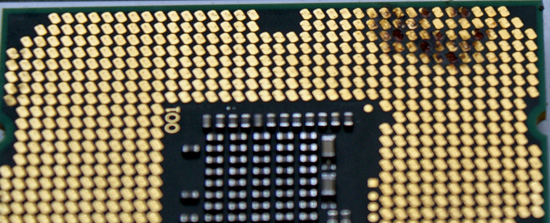
What happens after several extreme benchmark runs...
If you noticed something weird in the pictures then you understand the title of our article. We have what seems to be a potentially serious issue with proper socket loading on several P55-based motherboards when overclocking to the limit. We are of course not the only ones experiencing the problem as several of our overclocking peers have run into the same problem.
Normally we do not worry too much about mishaps during extreme overclocking testing as they are typically caused by factors outside of the supplier’s control. The overriding concern is that we have damaged every motherboard in our possession for the P55 overclocking (extreme) shootout as well as two very expensive i7/870 processors. These problems are the cause of a single component and are repeatable. As such, we thought we would provide details on current problems and will provide an update once all of the motherboard manufacturers affected have had a chance to properly respond.
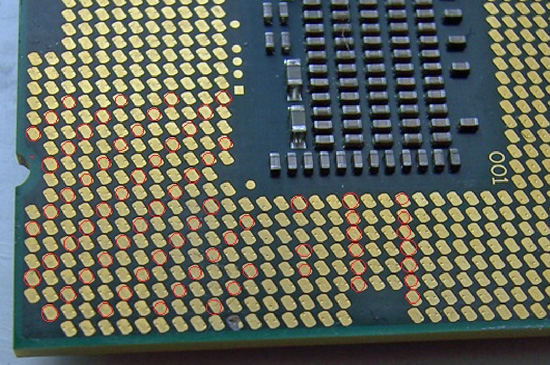
We draw your attention to the fact that the processor shown in this pictures exhibits signs of insufficient pin-to-pad contact (little to no contact) in what is a rather reproducible pattern with Foxconn manufactured 1156 sockets. As soon as an end-user mounts a CPU in a socket and latches the clamp mechanism, each pin should leave a notable mark on the associated pad.
We've marked locations where this does not seem to have happened, showing what appears to be a significant reduction in the number of VCC/VSS pins for proper power delivery, and certainly not at the right load line resistance. Damage resulting from highly overclocked use in these types of situations is not solely limited to the processor; let’s take a look at what happened to some of the motherboards in which these CPU were seated.
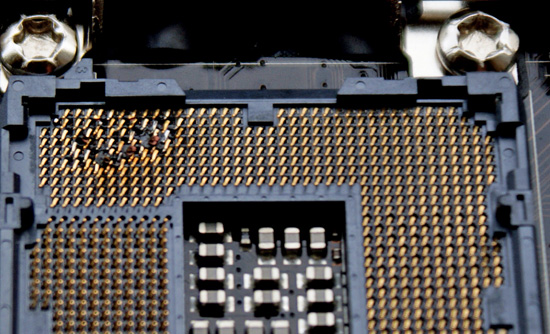
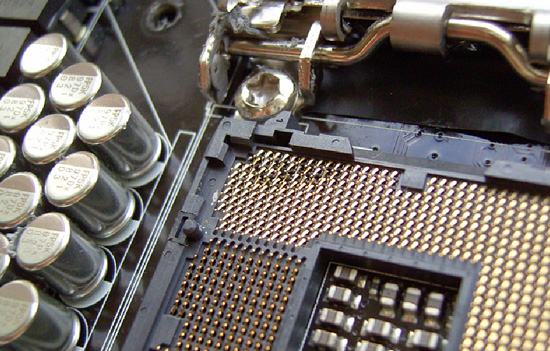
When Intel publishes socket specifications and design tolerances, it's up to component manufacturers to strictly adhere to them when designing, manufacturing, testing and ultimately selling their "compliant" components. Of course, that's not to say Intel could not have goofed when releasing their specification, leaving out a crucial tolerance or such. It could happen, but not likely. For the time being, let's assume that's not the case; seeing as how processors installed in sockets built by other companies have exhibited no such issue in testing to date.
At first glance, one might be inclined to think LGA-1156 based processors are intolerant of high-end overclocking, almost as if by design. This is correct to some extent; a quick glance at Intel’s white papers for socket 1156 CPU’s reveals that there are around 175 pads for VCC compared to over 250 for socket 1366 CPU’s. This means socket 1156 has around 66% of the current capacity of socket 1366, the caveat being that when overclocked, processors from both platforms draw similar levels of current.
When overclocked above 4GHz, processors from both platforms will draw around 15-16 amps via the EPS 12V rail to VCC, VTT and some of the other sub –system power rails under full 8 thread load from the Intel burn test (Linx). Assuming 85% PWM efficiency, we’re looking at power draw in the region of 130-140w to VCC on both platforms. The facts point toward tighter current handling tolerances for socket 1156 when compared to socket 1366, especially when it comes to non-connection of VCC/VSS power delivery pins.
Fortunately, we think we've been able to isolate pin to pad contact issues to one particular brand of parts. Physical inspection and end-user reports all but confirm the issues only affects sockets manufactured by Foxconn at this time. The only known alternative sockets in the wild are made by LOTES or Tyco AMP. We happen to have a couple of boards from EVGA using the LOTES/Tyco AMP sockets and MSI/DFI using the LOTES socket design, and thus far those boards have been issue free given highly similar operating conditions. In fact, we’ve managed to push our LGA-1156 processors further in heavy load tests on boards made using LOTES/Tyco AMP sockets than those made with sockets from Foxconn; something we’re not putting down solely to coincidence.
So far, EVGA is the only company we know that uses sockets exclusively from LOTES on their top-tier P55 boards - for example, the EVGA P55 Classified 200, model E659. This by the way may be the onus behind the decision to market the board’s “300% More Gold Content” socket statement as a purchasing option point. If you find yourself shopping for an EVGA P55 FTW, model E657, you've got a 50/50 chance of buying one with a Tyco AMP socket design (using a LOTES backplate), as opposed to one made solely with Foxconn's, the same goes for MSI and DFI who have batches of boards in the retail channel using LOTES sockets (although we're not entirely sure on socket specifics at this point). DFI told us earlier they have dropped usage of the Foxconn sockets completely until further notice. We hear the LOTES and Tyco AMP sockets are in short supply, which is probably why Foxconn's been able to fill the void in the market with what we believe to be a lower quality alternative for the extreme overclocker.
We took one of our damaged CPU’s and inserted it into one of the EVGA (LOTES/Tyco AMP) boards and took a few pics to show contact scoring and a side by side compare to the original Foxconn socket indents.
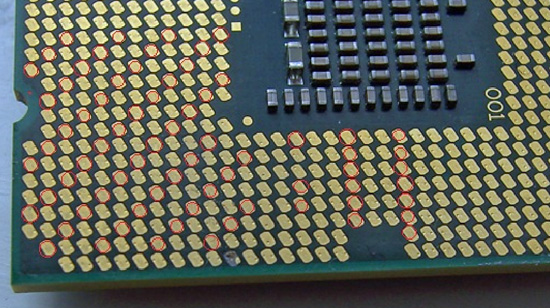
Foxconn 1156 Socket Installation
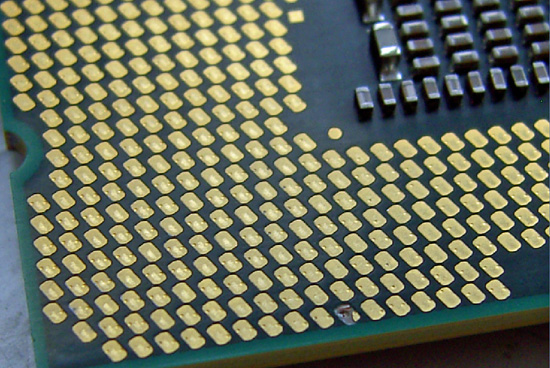
Tyco AMP / LOTES 1156 Socket Installation
Note how from a variety of angles certain pads show no evidence of contact from a Foxconn pin at all. Both the Tyco AMP and LOTES sockets have a larger pin/pad contact surface area leaving a slight scuff mark in the central area of each pad. In light of this, what we will say is that if you’re thinking of doing extreme overclocking on a board built using Foxconn's socket 1156, think again. Or, at least check your CPU for evidence of proper pin-to-pad contact.
We have not had any problems with air or water cooling overclocking up to 4.3GHz, although we do have a i5/750 that has developed a few dark pads after a thousand hours or so of constant overclocking. However, none of the boards have developed pin problems so we feel very safe in saying that any problems will probably occur only in extreme overclocking scenarios.
We also realize that partial responsibility for some of the less than acceptable CPU installations may be in fact due user installation errors. However, if users are screwing this up by doing nothing different than what they've always done when it comes to handling and installing LGA-type processors, then it's hard for us to find fault with the installer. Be aware of this situation and study the pin imprint on the CPU pads and make sure you have good contact on the VCC/VSS power delivery pads before pushing the system too hard.
















273 Comments
View All Comments
baldheadeddork - Tuesday, October 20, 2009 - link
I'll defer to Raja but I think you're mixing terms.The thermal design power (TDP) of the i5 series is 95 watts under load, but the CPU uses a lot more power - 120 watts at idle and at least 195w under load. The PCIe controller spec can provide up to 150 watts per device under load, but the TDP load for the controller is going to be substantially less. So low that the i5 CPU still stays under 200w TDP under load without hyperthreading.
dahwang - Tuesday, October 20, 2009 - link
Is there a reason why none of the other major tech blogs have picked up reporting on this? Other than a few other small blogs, I haven't seen a story similar to this. I would at least like to see a post from toms hardware or HardOCP. It'd also be nice to see a second viewpoint.JDD - Tuesday, October 20, 2009 - link
Here a couple of links but seems that they all point to Anand because Rajinder Gill was the first to break the story.http://www.hardforum.com/showthread.php?t=1460140">http://www.hardforum.com/showthread.php?t=1460140
http://www.xtremesystems.org/forums/showthread.php...">http://www.xtremesystems.org/forums/showthread.php...
vvelumm - Tuesday, October 20, 2009 - link
I just got off the phone with a Tech Support Supervisor aboutMaximus III Gene and the foxxconn issuse. He relentlessly told me they are doing testing and "THEIR" motherboard's have no issuses with foxxconn type. He basically guranteed over the phone that the maximus iii gene which all have the foxxcont bracket has no issues that is being talked about online.
To me it just feels like they are trying to cover their asses but i guess we won't know until someone tests it.
xcimo - Tuesday, October 20, 2009 - link
I agree!dingetje - Tuesday, October 20, 2009 - link
just give it some time...i predict these boards are gonna kill a LOT of cpu's...p55 will be known as a cpu killer by 2012 ;)michael19 - Monday, October 19, 2009 - link
Thank you for all the useful information Raja, keep it coming.SixOfSeven - Monday, October 19, 2009 - link
Yes, excellent summary of mfr responses, and much quicker than I expected.There have been a lot of responses stating that this problem only affects drastically overclocked boards and suggesting that it can be ignored by those running at stock (or mildly overclocked) speeds. The actions of Foxconn, Intel, and the other companies involved tell a different story. That they made a change to the part indicates either a) they believed there was a risk of problems at stock speeds or b) despite disclaimers, overclocking is really a supported activity and they believe they have to deliver products which function correctly when overclocked.
Syny - Monday, October 19, 2009 - link
So, I´ve read most of the discussions here, and I'm really worried about my i7 860 overclocked at 3.6Ghz with 1.246 voltage. I don´t exactly know, what do I have to expect from this Socket issue. I´ve got Gigabyte P55-UD5 Mobo which of course has Foxconn socket. So i´m asking as an ordinary user, who don't have any extra cash if something will happen with my CPU and MOBO ofc.Could this 3.6 overclock, affect proper function of my CPU in future, maybe after a year or two years of using this not so high overclocked i7 860 ???
I need some reliable answer/s, because im considering right now, if it won´t be better, to go back at my stock clocks.
ps: my english is bad i know :/, hope u´re going to understand what i want.
curtisfong - Monday, October 19, 2009 - link
C'mon people, read the article! This will not affect you unless you meet the conditions stated in the article.32nm chips will only exacerbate problems with the foxconn socket because voltage will be lower so amps will be higher, for a given power budget. Current capacity of a wire is not a function of power or voltage, it is function of amps. This is one reason why power transmission cables carry high voltage (amps remain low and the current capacity of the wire is not exceeded - the other reason is to minimize power loss). We should expect to see identical failures at lower power with 32nm chips vs. 45nm chips.
And to one of the posters above, no, a mild OC will not hasten failure on the socket. As long as the current capacity of the contact does not exceed its maximum load (which is partially dependent on the socket ie. foxconn vs. lotes / tyco) it will not experience failure.